Page Visit Log : thai_birds_of_prey
» Thai Birds of Prey
| Learn Thai | Thai Beaches | Thai Festivals | Thai Baht Rates | Thai Weather | Thai Recipes | Thai Music | Thai Tales | Thai Visa??? | Bangkok Maps |
If you enjoyed this page then you are sure to enjoy our pages on Wild Cats of Thailand, Thai Mongoose, Thai Civets, Thai Turtles, Thai Terrapins, Thai Snakes, Thai Langur, Thai Primates, Tokay Gecko, Thai Crocodiles, Water Monitor Lizard, Thai Fish, Thai Ducks, Hornbills, Thai Bats, Fence Lizard, Thai Scorpions, Thai Centipedes, Thai Butterflies, Thai Ants, Thai Hornets or the Rhino Beetle.
If you have any questions on Birds of Prey in Thailand why not post them on our Thai Animals Forum.
Thai Birds of Prey
Oriental Honey Buzzard
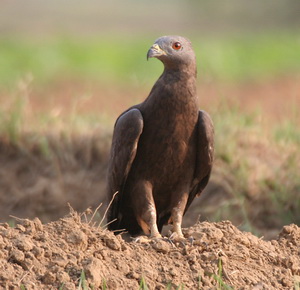
Science Name : Pernis ptilorhynchus
General Characteristics : The Oriental Honey Buzzard, Pernis ptilorhynchus, is a bird of prey in the family Accipitridae which also includes many other diurnal raptors such as kites, eagles and harriers. This species is also known as Oriental Honey-buzzard and Crested Honey Buzzard. It appears long-necked with a small head (resembling that of a pigeon), and soars on flat wings. The head lacks a strong ridge giving it a very un-raptor-like facial appearance. It has a long tail and a short head crest. There is a dark throat stripe. Unusually for a large bird of prey, the sexes can be distinguished. The male has a blue-grey head, while the female's head is brown. She is slightly larger and darker than the male. The male has a black tail with a white band, whilst the female resembles female Honey Buzzard.
Habitat / Food : It occurs in lowland broad-leafed evergreen and deciduous forest and open wooded country through out Thailand. Forms large flocks in migration. Feeds on bees, wasps, their larvae, and honey and wax.
Behavior / Mating : The Oriental Honey Buzzard breeds in woodland, and is inconspicuous except in the spring, when the mating display includes wing-clapping. The display of roller-coasting in flight and fluttering wings at the peak of the ascent are characteristic of the genus Pernis.
Current Status : Classified as non-endangered.
White Bellied Sea Eagle
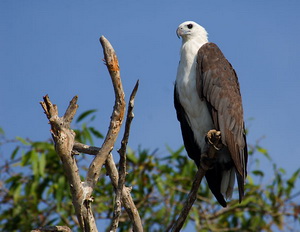
Science Name : Haliaeetus leucogaster
General Characteristics : The White-bellied Sea-eagle is one of the largest raptors in Southeast Asia. The sea eagle is white on the head, rump and underparts and dark grey on the back and wings. In flight the black flight feathers on the wings are easily seen when the bird is viewed from below. The large, hooked bill is a lead blue-grey with a darker tip, and the eye is dark brown. The cere is also lead grey. The legs and feet are yellow or grey, with long black talons. The sexes are similar. Males are 70–80 cm and weigh 1.8–3 kg. Females are slightly larger, at 80–90 cm and 2.5–4.5 kg. The wingspan ranges from 1.8 to 2.2 m. They soar on thermals holding their wings in a 'V' shape, unlike other raptors who hold them horizontally. Young Sea-eagles in their first year are predominantly brown. Their plumage becomes more infiltrated with white until they acquire the complete adult plumage by their fourth or fifth year. The loud "goose-like" honking call is a familiar sound, particularly during the breeding season; pairs often honk in unison.
Habitat / Food : They are a common sight in Thailand coastal areas, but may also be seen well inland. Birds are often seen perched high in a tree, or soaring over waterways and adjacent land. The White-bellied Sea-eagle hunts mainly aquatic animals, such as fish, turtles and sea snakes, but it takes birds, such as coots and shearwaters, and mammals as well. It is a skilled hunter, and will attack prey up to the size of a swan. They also feed on carrion such as dead sheep, birds and fish along the waterline, and may even raid fishing nets. They harass smaller birds such as Swamp Harriers, forcing them to drop any food that they are carrying. Sea-eagles feed alone, in pairs or in family groups.
Behavior / Mating : Birds form permanent pairs that inhabit territories throughout the year. They choose the tallest tree to nest, and even sometimes man-made pylons. The nest is a large deep bowl constructed of sticks and branches, and generally sited in large trees overlooking bodies of water. Cliffs are also suitable nesting sites, while those nests built directly on the ground are located on islands. Normally two oval dull white eggs are laid, although one is often ejected or broken. They measure 73 x 55 mm.
Current Status : Classified as non-endangered
Osprey
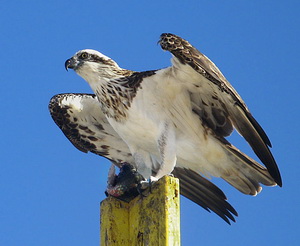
Science Name : Pandion haliaetus
General Characteristics : Ospreys are large birds of prey (55 to 58 cm long), with a wingspan ranging from 145 to 170 cm. Their long wings have a characteristic bend at the carpal ("wrist") joints. They are bright white underneath, with dark brown patches at the carpal joints and a mottled dark brown necklace. Other identifying markings include a dark stripe through each eye, and a dark brown back. The feet of this species are pale blue-gray, and the beak is black. Juvenile ospreys resemble adults, but have a somewhat speckled appearance due to buff-colored tips on their dark brown upper-wing and back coverts and a less well-defined necklace. Juveniles also have an orange-red iris, rather than the yellow iris that is typical of adults. Juvenile plumage is replaced by adult plumage by 18 months of age.
Habitat / Food : Found throughout Thailand. Ospreys have a wide distribution because they are able to live almost anywhere where there are safe nest sites and shallow water with abundant fish. Nests are generally found within 3 to 5 km of a water body such as a salt marsh, mangrove swamp, lake, bog, reservoir or river. Fish make up 99% of the Osprey's diet. It typically takes fish weighing 150–300 grams and about 25–35 centimetres in length, but the weight can range from 50 to 2000 grams. Occasionally, the Osprey may prey on rodents, rabbits, hares, amphibians, other birds, and small reptiles.
Behavior / Mating : Ospreys choose structures that can support a bulky nest, and that are safe from ground-based predators. Nest sites can be safe from predators either by being difficult for a predator to climb (e.g. on a cliff) or by being over water or on a small island. Over-water nest sites that are often used by ospreys include buoys and channel markers, dead trees and artificial nest platforms. Ospreys have also been known to nest on various man-made structures, such as power poles, communication towers, buildings and even billboards. The Osprey breeds by freshwater lakes, and sometimes on coastal brackish waters. Ospreys usually mate for life. Two to four eggs are laid over a period of several days, each 1 to 2 days apart. Both the male and female incubate the eggs, which hatch after approximately 40 days. Because incubation starts when the first egg is laid, the eggs hatch asynchronously in the order in which they were laid. Chicks that hatch first are larger and have a competitive advantage over those that are hatch later. If food becomes scarce, the smaller chicks are less successful in competing for food, and often die.
Current Status : Classified as non-endangered.
Eastern Marsh Harrier

Science Name : Circus spilonotus
General Characteristics : It is 48 to 58 cm long with a wingspan of 113 to 137 cm; like most birds of prey, the female is usually larger than the male. The male's plumage is variable; typically the head, breast, back and wing-coverts are blackish with pale streaks. The rest of the wing is grey with black wingtips and a white front edge. The tail is grey, the rump is white and the underparts are mostly white. The female is dark brown with buff streaking on the head and underparts. The rump is often whitish and the tail has dark bars. Young birds are dark brown with buff on the head and a pale patch on the underwing. It is usually silent but has a mewing call which is most often uttered at roost sites.
Habitat / Food : Found throughout Thailand. Its preferred habitat is open country including marshland, paddy fields and grassland. While hunting it flies low over the ground with the wings held in a shallow V-shape. Its prey includes small mammals, birds and frogs.
Behavior / Mating : The breeding season begins in April. The nest is made of sticks and built on the ground, usually in a reedbed. Four to seven eggs are laid which are incubated for 33 to 48 days. The young birds fledge after 35 to 40 days.
Current Status : Classified as non-endangered.
Peregrine Falcon
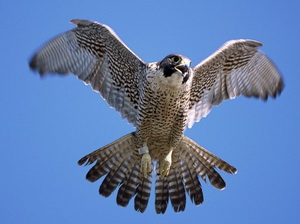
Science Name : Falco peregrinus
General Characteristics : The Peregrine Falcon has a body length of 34 to 58 centimetres and a wingspan of around 80 to 120 centimetres.The male and female have similar markings and plumage, but as in many birds of prey the Peregrine Falcon displays marked reverse sexual dimorphism in size, with the female measuring up to 30 percent larger than the male. Males weigh 440 to 750 grams and the noticeably larger females weigh 910 to 1,500 grams. The back and the long pointed wings of the adult are usually bluish black to slate gray with indistinct darker barring the wingtips are black. The white to rusty underparts are barred with thin clean bands of dark brown or black. The tail, colored like the back but with thin clean bars, is long, narrow and rounded at the end with a black tip and a white band at the very end. The top of the head and a "mustache" along the cheeks are black, contrasting sharply with the pale sides of the neck and white throat. The cere is yellow, as are the feet, and the beak and claws are black. The upper beak is notched near the tip, an adaptation which enables falcons to kill prey by severing the spinal column at the neck. The immature bird is much browner with streaked, rather than barred, underparts, and has a pale bluish cere and orbital ring.
Habitat / Food : Found throughout Northern Thailand and in the Bangkok area. The Peregrine Falcon lives mostly along mountain ranges, river valleys, coastlines, and increasingly in cities. The Peregrine Falcon feeds almost exclusively on medium sized birds such as doves, waterfowl, songbirds, waders and pigeons. Prey also include the small raptors. Other than bats taken at night, it rarely hunts small mammals, but will on occasion take rats, hares, shrews, mice and squirrels.
Behavior / Mating : The Peregrine Falcon is often stated to be the fastest animal on the planet in its hunting dive, the stoop, which involves soaring to a great height and then diving steeply at speeds commonly said to be over 320 km/h, and hitting one wing of its prey so as not to harm itself on impact. The Peregrine Falcon is sexually mature at the end of the first year of age but in healthy populations they breed after two to three years of age. The pair mates for life and returns to the same nesting spot annually. The courtship flight includes a mix of aerial acrobatics, precise spirals, and steep dives. The male passes prey it has caught to the female in mid-air. To make this possible, the female actually flies upside-down to receive the food from the male's talons. The Peregrine Falcon is territorial during the breeding season; nesting pairs are usually more than 1 km apart, and often much farther, even in areas with large numbers of pairs. The distance between nests ensures sufficient food supply for pairs and their chicks. Within a breeding territory, a pair may have several nesting ledges; the number used by a pair can vary from one or two to seven in a 16 year period. Mostly three to four eggs are laid. The eggs are white to buff with red or brown markings. They are incubated for 29 to 33 days, mainly by the female. The male also helps with the incubation of the eggs over day, but at night only the female incubates.
Current Status : Classified as non-endangered.
Barn Owl
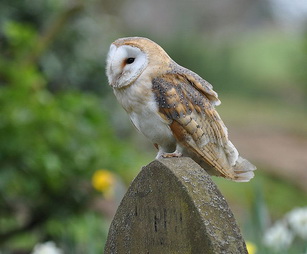
Science Name : Tyto alba
General Characteristics : The Barn Owl is a pale, long-winged, long-legged owl with a short squarish tail. Depending on subspecies, it measures about 25–45 cm in overall length, with a wingspan of some 75–110 cm. Tail shape is a way of distinguishing the Barn Owl from true owls when seen in flight, as are the wavering motions and the open dangling feathered legs. The light face with its heart shape and the black eyes give the flying bird an odd and startling appearance, like a flat mask with oversized oblique black eyeslits, the ridge of feathers above the bill somewhat resembling a nose. Its head and upper body typically vary between a light brown and a dark grey. Some are purer, richer brown instead, and all have fine black-and-white speckles except on the remiges and rectrices, which are light brown with darker bands. The heart-shaped face is usually bright white, but in some subspecies it is browner. The underparts vary from white to reddish buff, and are either mostly unpatterned or bear a varying amount of tiny blackish-brown speckles. The bill varies from pale horn to dark buff, corresponding to the general plumage hue. The iris is blackish brown. The toes, as the bill, vary in color; their color ranges from pinkish to dark pinkish-grey. The talons are black.
Habitat / Food : Found throughout Thailand. Tyto alba is nocturnal as usual for owls, but it often becomes active shortly before dusk already and can sometimes be seen during the day, when it relocates from a sleeping place it does not like. This is a bird of open country such as farmland or grassland with some interspersed woodland, usually below 2,000 m but occasionally as high as 3,000 m in the tropics. This owl prefers to hunt along the edges of woods. It has an effortless wavering flight as it quarters pastures or similar hunting grounds. Like most owls, the Barn Owl flies silently; tiny serrations on the leading edges of its flight feathers help to break up the flow of air over its wings, thereby reducing turbulence and the noise that accompanies it. It hunts by flying low and slowly over an area of open ground, hovering over spots that conceal potential prey. They may also use fence posts or other lookouts to ambush prey. The Barn Owl feeds primarily on small vertebrates, particularly rodents. Studies have shown that an individual Barn Owl may eat one or more rodents per night; a nesting pair and their young can eat more than 1,000 rodents per year.
Behavior / Mating : Breeding can take place at any time prey is abundant, and in the warm parts of its range may occur at any time of the year. An increase in rodent populations will usually soon cause the local Barn Owls to begin nesting; thus, even in the cooler parts of its range two broods are often raised each year. The male entices a female to its chosen nesting site, and courts her by circling around, chattering and screeching. Barn Owls nest in cavities, but they do not build a nest in the strict sense and just scrape together some debris. Most nest sites are in tree hollows, but in areas with much human activity, cavities in buildings are often used. The clutch is normally 3-6 eggs, usually 4 or 5, but up to a dozen have been recorded; they are laid every other day. The white eggs measure about 38–46 mm long and 30–35 mm (1.2–1.4 in) wide, and weigh some 21 g. Incubation is done by the female and lasts 30–34 days, and the nestlings are brooded for 2 weeks. The parents will continue to provision them for some 35–40 more days. After honing their hunting skills in the presence of the parents for another week or so, the young leave the vicinity of the nesting area and seek out a territory of their own.
Current Status : Classified as non-endangered.


